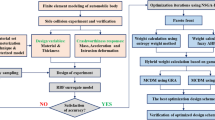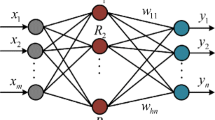Abstract
This paper proposes a hybrid method combining the Contribution Analysis Method, the Radial Basis Function Neutral Network (RBFNN)-Response Surface Method (RSM) hybrid surrogate modeling method, the Multi-Objective Particle Swarm Optimization (MOPSO) algorithm and the Technique for Order Preference by Similarity to Ideal Solution (TOPSIS), used for structure-material integrated multi-objective lightweight design of the front end structure of an automobile body. First, Contribution Analysis Method provides an effective approach to determine the final parts for lightweight design, and fourteen thickness variables and thirteen material variables are finally selected. Second, RBFNN-RSM hybrid surrogate modeling method successfully constructs the mapping between the input thickness-material variables and the output lightweight controlling quotas of the automobile body. Third, the MOPSO solves the multi-objective lightweight design process, considering the total mass and the torsional stiffness of the automobile body, the maximum impact acceleration at lower end of the B-pillar and the total material cost of the selected design parts as four conflicting objective functions. Accordingly, a set of Pareto-optimal solutions are obtained. Finally, a decision-making procedure based on TOPSIS method ranks all these Pareto-optimal solutions from the best to the worst for determining the best compromise solution. In addition, the proposed lightweight design method is demonstrated by the comparison among the baseline design, the actual experiment and the optimal design. The results show that the automobile body is lightweight designed with a mass reduction of 4.12 kg while other mechanical performance are well guaranteed. Hence, the proposed lightweight design method could be well applied to the lightweight design of the automobile body.




















Similar content being viewed by others
References
Ali H, Khan FA (2013) Attributed multi-objective comprehensive learning particle swarm optimization for optimal security of networks. Appl Soft Comput 13(9):3903–3921
Bai J, Li Y, Zuo W (2017) Cross-sectional shape optimisation for thin-walled beam crashworthiness with stamping constraints using genetic algorithm. Int J Veh Des 73(1–3):76–95
Belingardi G, Koricho EG (2014) Design of a composite engi-ne support sub-frame to achieve lightweight vehicles. Int J Autom Compos 1(1):90–111
Beume N, Naujoks B, Emmerich M (2007) SMS-EMOA: multiobjective selection based on dominated hypervolume. Eur J Oper Res 181(3):1653–1669
Chen W, Zuo W (2014) Component sensitivity analysis of conceptual vehicle body for lightweight design under static and dynamic stiffness demands. Int J Veh Des 66(2):107–123
Chen S, Shi T, Wang D, Chen J (2015) Multi-objective optimization of the vehicle ride comfort based on Kriging approximate model and NSGA-II. J Mech Sci Technol 29(3):1007–1018
Cui X, Wang S, Hu SJ (2008) A method for optimal design of automotive body assembly using multi-material construction. Mater Des 29(2):381–387
Deb K, Pratap A, Agarwal S, Meyarivan TAMT (2002) A fast and elitist multiobjective genetic algorithm: NSGA-II. IEEE Trans Evol Comput 6(2):182–197
Etghani MM, Shojaeefard MH, Khalkhali A, Akbari M (2013) A hybrid method of modified NSGA-II and TOPSIS to optimize performance and emissions of a diesel engine using biodiesel. Appl Therm Eng 59(1):309–315
Evora J, Hernandez JJ, Hernandez M (2015) A MOPSO method for direct load control in smart grid. Expert Syst Appl 42(21):7456–7465
Fonseca CM, Fleming PJ (1993) Genetic Algorithms for multiobjective optimization: formulation discussion and generalization. In: Icga 93:416–423
Gao Q, Wang L, Wang Y, Guo F, Zhang Z (2016) Optimization of foam-filled double ellipse tubes under multiple loading cases. Adv Eng Softw 99:27–35
Horn J, Nafpliotis N, Goldberg DE (1994) A niched Pareto genetic algorithm for multiobjective optimization. In: Evolutionary Computation, 1994. IEEE World Congress on Computational Intelligence, Proceedings of the First IEEE Conference on Ieee, pp 82–87
Jiang P, Wang C, Zhou Q, Shao X, Shu L, Li X (2016) Optimization of laser welding process parameters of stainless steel 316L using FEM, Kriging and NSGA-II. Adv Eng Softw 99:147–160
Khalili-Damghani K, Abtahi AR, Tavana M (2013) A new multi-objective particle swarm optimization method for solving reliability redundancy allocation problems. Reliab Eng Syst Saf 111:58–75
Knowles J, Corne D (1999) The pareto archived evolution strategy: a new baseline algorithm for pareto multiobjective optimisation. In: Evolutionary Computation, 1999. CEC 99. Proceedings of the 1999 Congress on, Vol 1. IEEE, pp 98–105
Kulak O, Kahraman C (2005) Fuzzy multi-attribute selection among transportation companies using axiomatic design and analytic hierarchy process. Inf Sci 170(2):191–210
Li H, Zhang Q (2009) Multiobjective optimization problems with complicated Pareto sets, MOEA/D and NSGA-II. IEEE Trans Evol Comput 13(2):284–302
Li Y, Qiang S, Zhuang X, Kaynak O (2004) Robust and adaptive backstepping control for nonlinear systems using RBF neural networks. IEEE Trans Neural Netw 15(3):693–701
Li YP, Liu HJ, Tong RH (2011) Lightweight scheme selection for car-body based on multi-objective satisfaction. Comput Integr Manuf Syst 17(1):37–44
Memariani A, Amini A, Alinezhad A (2009) Sensitivity analysis of simple additive weighting method (SAW): the results of change in the weight of one attribute on the final ranking of alternatives. J Optim Ind Eng 4:3–18
Mendoza F, Bernal-Agustin JL, Domínguez-Navarro JA (2006) NSGA and SPEA applied to multiobjective design of power distribution systems. IEEE Transactions on power systems 21(4):1938–1945
Mora AM, Merelo JJ, Laredo JLJ, Millán C, Torrecillas J (2009) CHAC, A MOACO algorithm for computation of bicriteria military unit path in the battlefield: presentation and first results. Int J Intell Syst 24(7):818–843
Mousavi SM, Sadeghi J, Niaki STA, Tavana M (2016) A bi-objective inventory optimization model under inflation and discount using tuned Pareto-based algorithms: NSGA-II, NRGA, and MOPSO. Appl Soft Comput 43:57–72
Ong CS, Huang JJ, Tzeng GH (2005) Building credit scoring models using genetic programming. Expert Syst Appl 29(1):41–47
Pan F, Zhu P, Zhang Y (2010) Metamodel-based lightweight design of B-pillar with TWB structure via support vector regression. Comput Struct 88(1):36–44
Saaty TL (2008) Decision making with the analytic hierarchy process. Int J Serv Sci 1(1):83–98
Shi G, Chen Y, Yang Y, Jiang X, Song Z (2012) BIW architecture multidisciplinary light weight optimization design. Jixie Gongcheng Xuebao (Chin J Mech Eng) 48(8):110–114
Srinivas N, Deb K (1994) Muiltiobjective optimization using nondominated sorting in genetic algorithms. Evol Comput 2(3):221–248
Tsou CS (2008) Multi-objective inventory planning using MOPSO and TOPSIS. Expert Syst Appl 35(1):136–142
Unal R, Lepsch R, McMillin M (1998) Response surface model building and multidisciplinary optimization using D-optimal designs. In: 7th AIAA/USAF/NASA/ISSMO Symposium on Multidisciplinary Analysis and Optimization, p 4759
Velea MN, Wennhage P, Zenkert D (2014) Multi-objective optimisation of vehicle bodies made of FRP sandwich structures. Compos Struct 111:75–84
Wang D, Jiang R, Wu Y (2016) A hybrid method of modified NSGA-II and TOPSIS for lightweight design of parameterized passenger car sub-frame. J Mech Sci Technol 30(11):4909–4917
Wang J, Cai L, Zhao X (2017) Multiple-instance learning via an RBF kernel-based extreme learning machine. J Intell Syst 26(1):185–195
Xiong F, Wang D, Zhang S et al (2017) Lightweight optimization of the side structure of automobile body using combined grey relational and principal component analysis. Struct Multidiscip Optim. doi:10.1007/s00158-017-1749-6
Ye H, Hu P, Shen GZ (2010) Lightweight optimization design of car body based on sensitivity and side crash simulation. Trans Chin Soc Agric Mach 41(10):18–22
Yoon KP, Hwang CL (1995) Multiple attribute decision making: an introduction (Vol. 104). Sage publications, Thousand Oaks
Yuan Y, Xu H, Wang B (2014) An improved NSGA-III procedure for evolutionary many-objective optimization. In: Proceedings of the 2014 Annual Conference on Genetic and Evolutionary Computation. ACM, pp 661–668
Zhang Q, Li H (2007) MOEA/D: a multiobjective evolutionary algorithm based on decomposition. IEEE Trans Evol Comput 11(6):712–731
Zhang Y, Lai X, Zhu P, Wang W (2006) Lightweight design of automobile component using high strength steel based on dent resistance. Mater Des 27(1):64–68
Zhou M, Pagaldipti N, Thomas HL, Shyy YK (2004) An integrated approach to topology, sizing, and shape optimization. Struct Multidiscip Optim 26(5):308–317
Zhu P, Zhang Y, Chen GL (2009) Metamodel-based lightweight design of an automotive front-body structure using robust optimization. Proc Inst Mech Eng Part D J Autom Eng 223(9):1133–1147
Zuo W (2015) Bi-level optimization for the cross-sectional shape of a thin-walled car body frame with static stiffness and dynamic frequency stiffness constraints. Proc Inst Mech Eng Part D J Autom Eng 229(8):1046–1059
Zuo W, Saitou K (2017) Multi-material topology optimization using ordered SIMP interpolation. Struct Multidiscip Optim 55(2):477–491
Zuo W, Xu T, Zhang H, Xu T (2011) Fast structural optimization with frequency constraints by genetic algorithm using adaptive eigenvalue reanalysis methods. Struct Multidiscip Optim 43(6):799–810
Zuo W, Yu J, Saitou K (2016) Stress sensitivity analysis and optimization of automobile body frame consisting of rectangular tubes. Int J Automot Technol 17(5):843–851
Acknowledgments
This research work was supported by the national key research and development project (2016YFB0101601) and State Scholarship Fund of China Scholarship Council ([2016]3100). The authors would like to express their appreciation for the above fund supports.
Author information
Authors and Affiliations
Corresponding authors
Rights and permissions
About this article
Cite this article
Xiong, F., Wang, D., Ma, Z. et al. Structure-material integrated multi-objective lightweight design of the front end structure of automobile body. Struct Multidisc Optim 57, 829–847 (2018). https://doi.org/10.1007/s00158-017-1778-1
Received:
Revised:
Accepted:
Published:
Issue Date:
DOI: https://doi.org/10.1007/s00158-017-1778-1




